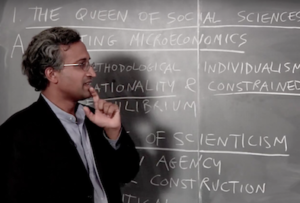An important part of the rhetoric of Mas-Colell, Green and Whinston’s Microeconomic Theory (as with other such texts) is that it employs formal or mathematical methods because this provides analytical ‘rigor’ (perhaps understood as a relation of logical inescapability tying conclusions to premises combined with a framework of generality underpinned by abstraction). On this view, mathematics, even if it serves as a barrier to entry to specialized discussions employing it, has a vital and irreplaceable role to play. The lack of comfort of many with mathematical ‘language’ in economics has, as a social fact, led to the establishment of a ‘language barrier’ making contemporary economics accessible to fewer people that it otherwise would be, and led to a return on investment to the initiated few who possess the requisite package of skills. The microeconomic theory curriculum plays a vital role in generating this stratification. Teachers and students spend enormous energy on the absorption and application of the mathematics necessary to modern economics, many winning and still more losing the battle. Nominated and aspiring ‘whiz kids’ (young and no longer young) meanwhile often prove their mettle by showing a breezy familiarity with these very matters. If for nothing else, examinations are useful for selecting mandarins!
Large Investment and Small Payoff?
Can a close reading of the text (we focus in particular on the early chapters on consumer and demand theory, which are challenging for many readers and students) justify the substantial role assigned to mathematical language and content? Is there an evident ‘return’ from the use of the specific mathematical abstractions employed and if so what is it? Paul Samuelson, in response to a challenge by Stanislaw Ulam, cited the principle of comparative advantage as a rare example of a result in economics which is both true and non-trivial.[1] Does the use of mathematical abstraction help to identify any results within the present domain possessing such a charmed combination? [The question is pressing: the damning alternative is after all to be false, trivial or both!]
Although there is considerable effort expended in the text to develop a framework of ostensible generality, sometimes at considerable cost in terms of ease (for instance, by employing the formalism of demand correspondences rather than functions) it is reasonable to ask what the payoff (to use the language of the microeconomists) of this labor is The forest of symbols and results may appear impressive to the uninitiated but what is beneath the emperor’s finery?
There is a strong case to be made that the most important results derived have no specifically economic content but instead simply reflect the choice of the adopted formalism. To put it simply: the description isthe content! The ostensibly most important results derived in the text merely follow as the necessary consequence of the characterization of consumers and firms as abstract automata engaged in relentless optimization of an objective function.
The ‘revelations’ of mathematical economics are from this point of view just side effects of using a certain mathematical formulation (and as we shall see, rather general formulations at that, such as the very idea of maximization subject to constraints) to describe the world. The ‘findings’ of the theory are thus a consequence of the ‘language game’ imposed. They tell us nothing about the world other than that if we choose to describe it in a certain way than that will necessarily in turn bring in train other aspects of a description. When the premises entering a formulation lack in realism, the logical consequences of those premises, however inexorable, may also bear little relation to reality. However, even when the premises chosen are realistic, it is important to understand what in the conclusions derived comes from specific economic ideas (such as utility or profit maximization or the idea that a production plan is irreversible) and what comes from mathematical ideas with no intrinsic economic content (such as the idea of maximization as such). The propositions derived may be neither verifiable nor falsifiable (such as where they concern the putative relation between different imaginary objects such as the Hicksian demand function and the expenditure function) or they may be so under sufficient auxiliary hypotheses (as in the case of testing WARP under the hypothesis of unchanging preferences etc.). Some awareness of what results are simply a consequence of a general (not even specific) mathematical form is essential, whether or not one worships at the altar of falsifiability, so that one may tell wheat from chaff.
Discovering New Continents?
Below we list what appear to be examples of seeming ‘discoveries’ (taken from the first chapters of the text) which might be thought by some to possess empirical economic relevance. Although there is no clean distinction, we focus on propositions which are mediated by the theory but involve at least one potentially observable empirical idea (in contrast to ones which define the internal relations involving only abstract component of the theory.
Here are some candidate discoveries from chapters 1-3:
- The Walrasian (called Marshallian elsewhere) demand function for a good satisfies the compensated law of demand, which demands that the cumulative effect of price increases must be ‘on balance’ negative, if (i) the demand function is homogeneous of degree 0, (ii) satisfies Walras’ law, and (iii) satisfies WARP [Proposition 2.F.1, pp. 30-31].
- The incremental effect on the Hicksian demand for a good of an increase in its own price must be negative. The incremental effect on the Walrasian demand for a good of an increase in its own price can be positive or negative (and can be parceled through the Slutsky equation into income effects — positive or negative — and substitution effects — negative) [Proposition 3.G.2 and 3.G.3, pp 69-71].
- The incremental effect on the Hicksian demand for a good of an increase in the price of another good can be negative or positive but the cumulative effect of price increases must be ‘on balance’ negative as captured by the compensated law of demand (Proposition 3.E.4, p.62).
- The incremental effect on the Hicksian demand for a good of an increase in the price of another good must be equal to the incremental effect on the Hicksian demand for the latter good of an increase in the price of the former good [Proposition 3.G.2, pp.69-70].
The first of these ‘discoveries’ attempts to provide a link between WARP and observed behavioral response (Walrasian demand) to a specific observed environmental shift (change in prices with Slutsky compensated wealth adjustment). The result does not explicitly assume maximization of an objective but introduces its elements through Walras’ Law (which demands that all wealth be expended) and through WARP (which required behavior compatible with such an assumption) and is driven entirely by the combination of these (see proof on p. 31). In this context, it is not surprising, and is merely the multi-good extension of a property which takes trivial forms in the one and two good cases. [A side remark is that this proposition appears to provide an additional empirical basis for potential falsification of WARP: it holds if and only if price and demand move in opposite directions for all compensated price changes. However, the methodological concern classically raised by Duhem and Quine arises, here as in other cases. The result cannot be tested independently of background assumptions; in particular, that the demand function is homogeneous of degree zero (relatively although not wholly inoffensive) and that it satisfies Walras’ law (less so, especially as consumer behavior may only be sufficiently observed over a period in which a budget is meaningfully intertemporal — as indicated in the text on p.23)].
The remainder of these ‘discoveries’ involve the effect on an unobservable concept (Hicksian demand) of an observed environmental shift (change in prices). These propositions are therefore also unfalsifiable. In each case such propositions are also general consequences of the abstract mathematics of optimization rather than of any specifically economic content or interpretation of the optimization exercise. Both the second and third ‘discoveries’ flow directly from the negative semi-definiteness of the matrix of first derivatives of the Hicksian demand function, which in turn flows from the concavity of the expenditure function. The latter property is, however, a consequence of the premise of maximization of utility (which entails minimization of expenditure to achieve a given utility level) from which concavity of the expenditure function flows as a primitive consequence. Failure to adjust the pattern of expenditure when experiencing a price change would imply a linear expenditure function (as such, a demand adjustment in the direction of expenditure reduction implies a concave expenditure function). [Results based on the envelope theorem or its equivalent, employed as lemmas along the way to these results, are also a consequence of the premise of maximization as such]. Once the language of utility maximization has been adopted, both the second and third propositions flow as purely formal consequences.
The fourth ‘discovery’ (arguably, a prima facie candidate for membership in the set of results which are at once non-trivial and non-obvious) is a consequence of the fact that the expenditure function is dependent on a state alone (specifically, prevailing prices, preferences, and the utility level sought to be attained) — and not of the process by which that state was achieved. Further, and (rather more technically) the result follows from the fact that the second derivatives of the expenditure function are assumed to exist and be continuous. As a result, Young’s theorem which applies to any real valued function with such properties, implies (since any real valued function can be interpreted as a state-dependent function which takes values which are independent of the paths in the parameter space traversed to arrive at a relevant point in that space) the symmetry of its matrix of second derivatives. This result too is seen, therefore, to be an immediate consequence of the ‘metaphor’ of utility maximization.
The question is therefore raised as to whether the derived results have any independent economic content or merely reduce to ‘figments of mathematics’ — more expression than revelation. Is it possible to find propositions in consumer and demand theory, or for that matter in the theory of the firm (where parallel results to those mentioned above are derived, with the profit function serving as the real-valued state-dependent function which acts analogously to the expenditure function, maximized rather than minimized, and convex rather than concave) which can be classed as achieving Ulam’s desiderata, by being non-trivial and non-obvious? Do we learn something new and important by adopting specific mathematical metaphors? Even if (as we are suggesting here) we do not, this does not mean that the metaphor chosen does not have its uses. Indeed it is undoubtedly in part because such metaphors have their uses (in description, in interpretation, in justification, and so forth) that they are adopted, regardless of their truth value.
Extending the scope of our discussion: there is much to explain which cannot be captured by the logic of maximization (whether of utility or profit) through the pursuit of (static) allocative efficiency. For instance, both firms and individuals may in many contexts be better understood as transformable and transforming actors than as static optimizers, ever learning about themselves and others through engagement with the world[2]. In lieu of listing such ideas, we may rest content with quoting Shakespeare:
“There are more things in heaven and earth, Horatio,
Than are dreamt of in your philosophy” [Hamlet, Act 1, Scene V].
[1] Samuelson, P.A. (1969), “The Way of an Economist”, in International Economic Relations: Proceedings of the Third Congress of the International Economic Association, London: Macmillan, pp. 1–11.
[2] On which see e.g. Piore, M.J. (1995), Beyond Individualism, Cambridge, MA: Harvard University Press [esp. chapters 4-5], and Lazonick,W. (1991), Business Organization and the Myth of the Market Economy, Cambridge: Cambridge University Press [esp. Ch. 3,6,7].




